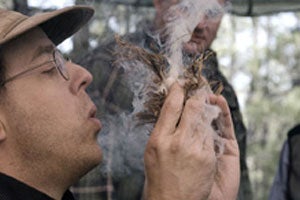I know many bush pilots, hunters, and hikers in the northern regions who carry a small down sleeping bag as part of their “survival-kit” during the colder months of the year. With this tool, you won’t have to burn precious calories building an insulated shelter and gathering loads of firewood.
Tony Nester
 Tony Nester
Tony NesterBut, let’s assume the worst-case scenario—you have only the clothes on your back and your daypack—what then? As hypothermia is your number-one concern, fire and shelter tops your survival priorities list. By fire, I don’t mean a little campfire for roasting marshmallows but rather a fire as long as you are tall. On my winter survival courses in the snow, where we sleep out with very little gear to simulate a worst-case scenario, we build pine-bough beds around a fire that is about six-feet long and piled knee-high with large-diameter logs.
If fire-danger is high and there’s little snow on the ground, then we use a different method to cast a “heat bubble.” After the fire is going, pile up some logs behind you—about waist-high—to provide some backing and cut the wind. A lean-to is another good shelter but may be difficult to construct if you are injured, dehydrated, or just low on calories. The bough-bed and fire combo above is a good place to start. Add to it depending on your needs, available resources, and energy level.
Always carry three fire-starting devices and tinder (a dozen cottonballs smeared with Vaseline). With these items and the will to live, one can prevail through a brutally cold night in the elements.


